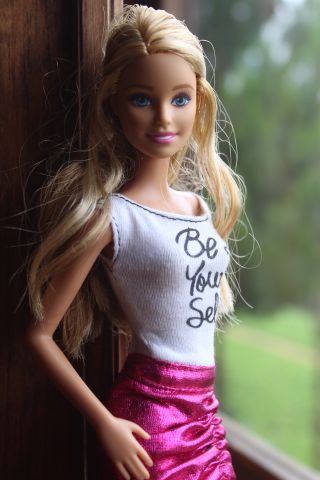Media
Barbie: A Complex and Evolving Icon
Personal Perspective: Mothers play key, but often overlooked, roles in the film.
Updated July 26, 2023 Reviewed by Ray Parker

Barbie, the movie directed by Greta Gerwig, tackles many contradictions about women—sometimes with humor and irony, other times falling back on shallow fantasies of female versus male world domination.
The film tackles many contradictions about women
The beginning of the Barbie movie seemed to be making fun of itself. Everyone hates stereotypical Barbie. Girls hate Barbie because they can’t live up to Barbie’s perfection.
Boys hate Barbie because she is a useless doll without a vagina. Everyone is happy in Barbie’s world because “the patriarchy” does not exist there. Ken’s only function is to be Barbie’s accessory.
The story’s climax occurs when Ken discovers the patriarchy and turns Barbie’s world into one dominated by men. Things get dark and ugly quickly with lots of TVs and horses. Luckily, Barbie ultimately triumphs by restoring Barbieland to a pink, bright feminine, dominated world. Phew!
But perhaps the film’s most unique and thought-provoking aspect was its treatment of motherhood. Barbie is not a mother unless you count her influence on the millions of young girls who loved and hated the icon, and aspired to be just like her or vowed to be nothing like her.
Created by Ruth Handler in 1959, Barbie was the first grown-up doll for young girls. Baby dolls were designed to help little girls practice being mothers and looking after others. Barbie allowed little girls to practice who they could become if they looked after themselves.
A mother created Barbie for her daughter and as a representation of her daughter. “We mothers stand still so our daughters can look back to see how far they’ve come,” Ruth Handler (played by Rhea Perlman) tells Barbie (played by Margot Robbie) in one of the film’s most fascinating lines.
She references her relationship with her daughter, Barbara Handler, whom Barbie was named after. But she may also have considered Barbie the doll herself, whom Ruth Handler imagined, designed, championed, and brought to the world.
To be sure, Barbie means something different now than she did to the children of the '60s. But the doll continues to symbolize the “I can do anything” mindset many young women embrace. The commitment to continue to grow, change and essentially become more than their often less visible mothers is a theme that persists across generations. Ruth tells Barbie, “I knew you would always surprise me.”
As a child, I was called “Barbie” and am now around the same age as the doll. I’ve felt the weight of these hopes and dreams throughout my life. The film allowed me to reflect anew on how much being called “Barbie” growing up influenced me.
I was adopted in the early '60s by parents eager to have a child. It was the era when success and happiness meant marriage and kids. I always knew my purpose was to make my parents’ lives happy and complete.
My parents told me they wanted a little girl with blonde hair and blue eyes, and when they saw me, they knew I was the one. So as a kid, I imagined my parents going to the baby store and searching the aisles, then when they saw me, they exclaimed, “There she is; she’s the one.”
I imagined them taking me down from the shelf (usually on the top), putting me in the shopping cart, going through the check-out, putting me in the car, driving me home, placing me in my fluffy, pink room—and delighting in my presence forever after.
The pressure of expectations increased slowly at first, like the proverbial frog in hot water. Then when I reached my teens and 20s, the onslaughts of contradiction reached a fever pitch, so well-articulated in the rant by Gloria, the mother in the real world (played by America Ferrera), about the weight of contradictory messages for women, "We have to always be extraordinary, but somehow we’re always doing it wrong….”
Growing up being called Barbie was someone else’s dream that I could not fulfill. But what now that Barbie is older? At 64, the Barbie doll remains smooth and ageless, slender waist and perky bust—without any reproductive organs, illnesses, cellulite, or blemishes. It is not the same for me.
Where do older Barbies go in real life?
In one of the most emotional scenes in the movie, Barbie encounters an older woman at the bus stop. Barbie says spontaneously, “You’re beautiful.” The older woman replies without hesitation, “I know."
In interviews, Gerwig explained that the scene almost didn’t make it to the big screen. Film executives suggested she cut out the scene before the film’s release. In an interview with Rolling Stone, Gerwig explained,
I love that scene so much...the older woman on the bench is the costume designer Ann Roth. She’s a legend. In a way, it’s a cul-de-sac of a moment—it doesn’t lead anywhere. And in early cuts, looking at the movie, it was suggested, ‘Well, you could cut it. And actually, the story would move on just the same.' Gerwig said, 'If I cut the scene, I don’t know what this movie is about. That’s how I saw it. To me, this is the heart of the movie.'
Mothers and older women play a key, yet potentially overlooked role, in the film
Perhaps it is the heart of the mother. In the movie, as in life, mothers often support their daughters behind the scenes—and to some, their presence might seem superfluous—yet if you cut her out, you’ll cut the heart out of the story.
Barbie is a mother’s creation. It’s lovely to see Gerwig acknowledge the creativity of older women and give a respectful, appreciative, and somewhat stealthy nod to mothers. Mothers and older women play a key yet potentially overlooked role in the film, as in life.
Copyright 2023 Tara Well PhD




